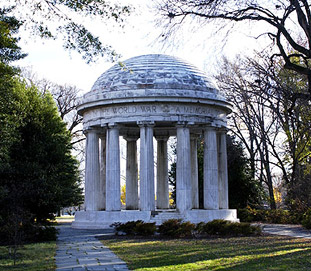
Nice plan, except that there is no national WWI Memorial. On 11 November 1921, the Tomb of the Unknown Soldier was dedicated in a ceremony which was relayed by telephone to New York and San Francisco.
[“In the open air the President’s voice swept over the crowd in Madison Square,” enthused The Times‘ man on the scene. “The Voice seemed to come from the chest of a giant…Carried by wire from Washington, [it] was heard more clearly that that of Colonel Theodore Roosevelt and Martin Littleton, whose voices were amplified as they spoke from the platform in the Garden.” God Bless America(n Telephone & Telegraph).]
Presidents laying a wreath at the Tomb of the Unknowns became an Armistice Day tradition. But eventually, the soldier disinterred from Belleau Wood was joined by representatives from later wars, expanding he Tomb’s purview. As a result, specific remembrance of the horrors and sacrifices of WWI were conflated into the larger struggles of the century.
The traffic at Arlington was a mess; after sitting in misdirected lines for nearly an hour, I left without even a glimpse of the parking lot, much less the Tomb. Many in the crowd were veterans, though, families in tow. I went on to my second destination, across the Memorial Bridge, to the south edge of the Mall.

I was the only visitor during the half hour I was there. Three Park Service rangers–two in WWI-era uniforms–were breaking WWI-era camp in the little temple. For three years now, they have taken it upon themselves to create a little interpretive history opportunity for any visitors. Last year, when detours for the WWII Memorial construction closed off many other pathways, the rangers had quite a turnout. This year was much quieter. The two rangers in period uniform participate in WWI re-enactments with the Great War Association. Unlike Civil War re-enactments, however, there is no audience; there are practically no spectators, only participants.

Britain created the Cenotaph as a Memorial to the Great War, and it has woven taught WWI into the national identity. They built The Memorial to the Missing–the subject of my first film, and an inspiration for Maya Lin’s Vietnam Memorial design just across the Reflecting Pond from the DC War Memorial–in France, an outpost for British memory. The names of just The Missing from just The Somme exceeded 75,000.
DNA testing helped identify the Unknown Soldier from Vietnam, and his remains were reburied in 1998. Until September 11th, it was assumed there would be no more Unknowns or Missing, but that turns out not to be the case. The World Trade Center Memorial will hold the presently unidentifiable remains of those killed, in hopes that technology will someday match them up to the 1,271 individual names. The New Missing, on the other hand, are frequently those who have been wounded or killed in Iraq. Witness to the fresh horrors of war, it seems, must come from the unlikeliest of sources: Cher calling into C-SPAN with stories of brave 19 year-olds who’ve lost arms and legs, just a few of the 2,100+ GWII casualties who are shunned and obscured by the Administration.
In Sunday’s Washington Post, the playwright Norman Allen–an old man, I take it–lamented the fading of Armistice Day:
I first heard tales of the war’s devastation from my grandfather, who was 19 when he was wounded not far from Chateau Thierry, an hour’s drive from Paris. In middle age, he spoke in generic terms of his heroic comrades, Iowa boys like himself. In early senility, he spoke in detail of struggling across a field under heavy fire. Glancing to the left, he saw a friend’s head blown away. He told me, “Never go to war. No matter what.” My generation is the last to hear these things firsthand.
Well, his generation–and Cher.
